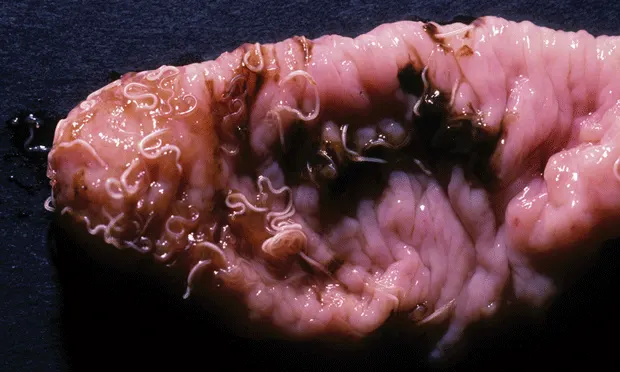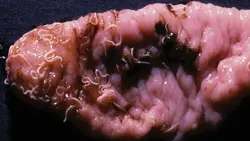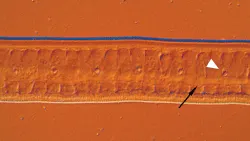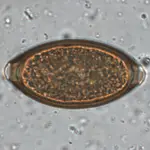Treating Whipworms in the Dog

You have asked…
Do I need to treat whipworm infection before starting a monthly heartworm preventive that is also labeled for whipworm?
The expert says…
Whipworm (Trichuris vulpis) is a parasite of the cecum and colon of dogs.1-3 Although dogs may present no clinical signs, heavy infections can cause bouts of diarrhea (with mucus and frank blood) that alternate with periods of passing normal stools. In light infections, the worms are restricted to the cecum, but as the parasite burden increases, worms are found more distally into the colon. In very heavy infections, worms can cover almost the entire wall of the large bowel, from cecum to rectum.
Related Article: Canine Diarrhea
Clinical signs appear to be due mainly to the number and physical presence of worms that have their anterior ends threaded through the colonic mucosa. Whipworms, both males and females, live with their anterior thin, whip-like stichosome esophageal portion of the body threaded within the surface epithelium of the large bowel wall (Figures 1 & 2). The host reacts with inflammatory cells, including eosinophils, and blood is lost into the bowel lumen. The posterior of the worm’s body is free within the lumen of the large bowel. The vulva of the female worm is located where the body leaves the mucosa. The male has a tail that ends with several spirals and looks like a coiled spring (Figure 3). Mating probably occurs regularly, with the male wrapping its spring-like body around the female. A single spicule has a sheath covered with spines. It takes approximately 74 to 90 days for adult females to begin passing eggs into the host's feces. The eggs, which are football or lemon shaped (Figure 4), are not infectious when passed but require several weeks in soil to develop into infective larvae within their eggshell. The life cycle is direct, with infection by ingestion of eggs in soil or soil-contaminated objects. Once whipworms reach adulthood, they probably do not change their location within the intestine.
Related Article: The Elusive Whipworm, Trichuris Vulpis

Figure 1. Inverted cecum of a dog at necropsy. Note the relatively small number of whipworms. Only the thick portion of the worms is visible. The long anterior end with the stichosome esophagus is embedded in the intestinal mucosa.
Figure 2. The stichosome esophagus in the anterior portion of the whipworm. The esophagus is glandular with several large cells in the surface forming large folds. At about every third fold, a nucleus is visible in the center of each cell (white arrowhead). Running along the length of the esophagus, about halfway between the nuclei and the ventral border, the small lumen of the esophagus can be observed (black arrow).

Figure 3.Two male and 1 female Trichuris vulpis in a dish showing the curled tail of the males and the long anterior esophageal portion of the worm that had been embedded in the mucosa.

Figure 4. Trichuris vulpis egg from a canine fecal sample showing the typical polar plugs and the single cell present in the egg when passed.
_Related Article: Fecal Sample Analysis**
WHIPWORM FACTS**_<sup4sup>
Trichuris vulpis occurs in the dog, fox, and coyote.
Whipworm eggs can remain viable in the environment for years.
Each female Trichuris vulpis can produce more than 2000 eggs/day.
Infected animals may show clinical signs before eggs are shed in feces.
Eggs may be shed intermittently.
Eggs are quite dense and difficult to float.
Centrifugation with Sheather’s sugar solution or zinc sulfate solution increases the sensitivity of whipworm egg detection.
CURRENT CANINE WHIPWORM PRODUCTSSix products are currently approved for canine whipworm treatment in the U.S. (Table 1):1. Fenbendazole Q 24 H at 50 mg/kg for 3 days.2. Febantel once at 25 mg/kg, formulated with 5 mg/kg praziquantel and 5 mg/kg pyrantel pamoate3. Milbemycin oxime monthly at 0.5 mg/kg, formulated alone4. Milbemycin oxime monthly at 0.5 mg/kg, formulated with 10 mg/kg lufenuron5. Milbemycin oxime monthly at 0.5 mg/kg, formulated with 30 mg/kg spinosad6. Moxidectin monthly at 2.5 mg/kg, formulated with 10 mg/kg imidacloprid
All 6 products have similar efficacies when administered one time per labeled dosing protocol.
Because of the long prepatent period of whipworms and the typical reduced efficacy of many anthelmintics against larval intestinal worms when compared with adults, veterinarians often administer fenbendazole or febantel formulated with praziquantel and pyrantel 2 additional times to clear dogs of any newly maturing worms. The other 4 products that include milbemycin oxime or moxidectin are labeled for monthly administration as heartworm preventives and routinely kill any adult whipworms with each administration.
PIVOTAL DATA AND LABEL CLAIMSThe current Guidance for Industry document from the Center for Veterinary Medicine (CVM) of the Food and Drug Administration (FDA) suggests the following pivotal data for a label claim:
Two studies, each with 6 adequately infected control and treated dogs in which the worms are counted at necropsy
A statistically significant (p < 0.05) difference in parasite counts between the control and treated dogs
Efficacy > 90% with one treatment when the geometric means are compared between the treated and untreated dogs
Earlier claims were granted under guidelines that required > 90% efficacy but may not have required as many studies or may have allowed critical trials to be conducted. In critical trials versus controlled trials, the animal serves as its own control in that effectiveness of the product is determined by a comparison of each animal’s degree of parasitism before and after treatment. These studies require fecal collection after treatment to determine the number of worms passed as well as worm counts at necropsy.
KEY POINTS
Whipworms are parasites of the cecum and colon of dogs.
Clinical signs appear to be mainly due to the number and physical presence of worms that have their anterior ends threaded through the mucosa.
Currently 6 products are approved for canine whipworm treatment in the U.S.
There is no need to treat whipworm-infected dogs before starting monthly broad-spectrum intestinal parasite treatment and heartworm prevention with products labeled for whipworm efficacy.
AND THE ANSWER IS...Because all 6 products have similar efficacies, there is no need to treat whipworm-infected dogs before starting monthly broad-spectrum intestinal parasite treatment and heartworm prevention with products containing oral milbemycin oxime or topically applied moxidectin. Because these eggs are environmentally resistant while in soil, reexposure and reinfection are common, providing another reason for repeated treatment or the use of monthly administered products.
Dr. Mannella is a senior professional services veterinarian with Novartis Animal Health US, Inc.
TREATING WHIPWORMS IN THE DOG • Dwight D. Bowman & Claire Mannella
References
1. Intestinal nematodes: Biology and control. Epe C. Vet Clin North Am Small Anim Pract 39:1091-1107, 2009.
Trichuris and other Trichinelloid nematodes of dogs and cats in the United States. Campbell BG. Compend Contin Educ Pract Vet 13:769-773, 776-778, 1991.
Nematode Parasites of Domestic Animals and Man. Levine ND—Minneapolis, MN: Burgess Publishing, 1988, pp 421-422.4. Whipworm facts, online. Companion Animal Parasite Council; http://capcvet.org ; accessed Dec 16, 2010.5. Guidance 111, Guidance for industry: Effectiveness of anthelmintics: Specific recommendations for canine. June 27, 2002; VICH GL 19; http://fda.gov/downloads/AnimalVeterinary/GuidanceComplianceEnforcement/GuidanceforIndustry/ucm052652.pdf, accessed Dec 16, 2010.